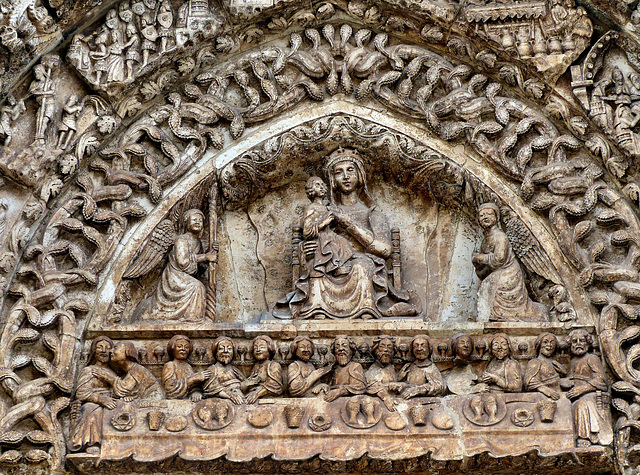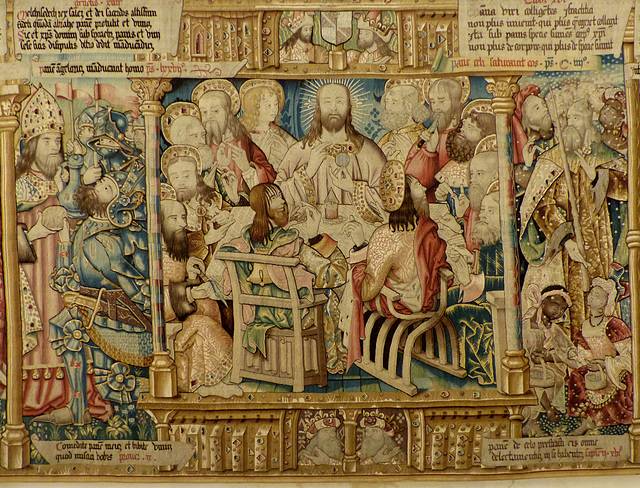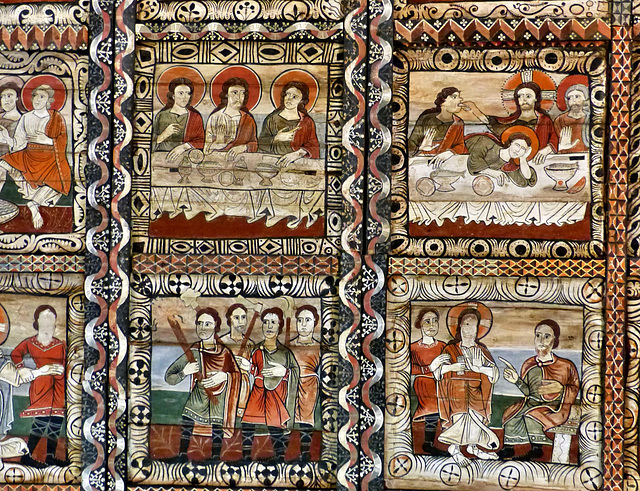
The Last Supper
"La Cène" / Das letzte Abendmal
Buggingen - Betberg
Betberg is a little hamlet, belonging to Buggingen. The name "Betberg" sounds like a "program", "bet" means "pray" and "berg" means "mountain". Betberg had of the earliest churches in the area. The church was first mentioned in 789, but brick foundations, found during a renovation in the 1970s date from around 700.
The current church was probably built between 1100 and 1145. The tower was erected around the year 1200. Of course the church underwent numerous alterations, enlargements and renovations over the centuries.
The entrance hall has four large frescoes from the early 16th century. The best preserved is the "Last Supper"
Altamura - Cattedrale di Santa Maria Assunta
The area around the modern Altamura (pop 70.000) was inhabited in early times. There are Bronze Age tumuli and between the 6th and the 3rd century BC a massive line of megalithic walls was erected. This (later Roman) city was inhabited until the 10th century when it was reportedly looted by Saracens. A couple of centuries after Altamura was reportedly looted by the Saracens, it started to be inhabited again as Emperor Frederick II refounded the city (1232) and ordered the construction of the large Altamura Cathedral, which became one of the most venerated sanctuaries in Apulia.
Altamura was ruled by various feudal families, including the Orsini del Balzo and the Farnese (1538–1734), the latter responsible for the construction of numerous palaces and churches. In the past, Altamura also had a large castle, whose construction dated back to the 11th-13th century, which has been completely demolished.
Altamura Cathedral (Cattedrale di Santa Maria Assunta) was founded by Emperor Frederick II in 1232. In 1248, under pressure from Frederick, Pope Innocent IV declared Altamura exempt from the jurisdiction of the bishop of Bari, making it a "palatine church", that is the equivalent of a palace chapel. After heavy damage caused by an earthquake in 1316, it was renovated by Robert of Anjou.
Major changes were made to the cathedral in 1534, including switching the front and back around! The cathedral's main facade originally faced west but it now faces east.
The (breathtaking) attraction of Altamura Cathedral is its main portal, which has been dated to the 14th and 15th centuries. It is Gothic, but in an unusual local style with Byzantine and strong Romanesque influences. I would even see this as "Romanesque/Gothic". It is remarkable for its wealth of details and a large number of biblical scenes.
The tympanum above the lintel, that depicts the Last Supper, is the crowned and enthroned Virgin holding Jesus, flanked by angels. The small scenes on the sides show left the Flagellation and the Betrayal, right the Marriage at Cana (?) and ???.
La Chaise-Dieu
La Chaise-Dieu was founded in 1043 by Robert de Turlande. It was named "Casa Dei", from which La Chaise-Dieu developed. From the 11th to the 13th century, the abbey experienced rapid and significant development. When the founder died in 1067, already 300 monks lived here. In the Auvergne La Chaise-Dieu gained importance similar to that of the Burgundian Cluny Abbey. The abbey received many donations from noble families and administered 42 daughter monasteries. Popes who visited the abbey include Urban II, Calixt II, Alexander III. and Innocent II. In 1342, Pierre Roger, who had lived as a monk in La Chaise-Dieu, became Pope in Avignon under the name Clement VI. He financed a new building of the abbey church, in which he was finally buried. The building was completed in 1378 under the pontificate of Gregory XI, a nephew of Clement VI.
Since 1516 La Chaise-Dieu, like most other French abbeys, became "in commendam" so the commendatory abbot drew the revenue of the monastery but without fulfilling the duties of the abbot or even residing at the monastery.
Calvinist troops looted the abbey in August 1562. After most of the monastery buildings were destroyed by fire in 1695, they were rebuilt by the monks in the decades that followed. In 1786, Cardinal de Rohan, who was involved in the "Affair of the Diamond Necklace" was exiled to La Chaise-Dieu. While the abbey had 40 monks at that time, religious life ended at the beginning of the French Revolution.
La Chaise-Dieu is known for the tapestries, once woven to embellish the monks´ choir.
They were commissioned by Jacques de Saint-Nectaire and were woven by a Flemish workshop between 1501 and 1518.
The collection includes 14 tapestries of which two are different and may have been ordered by the abbot for his personal use.
The 12 other tapestries constitute a complete continuation of the Annunciation to the Last Judgment. An inventory prior to the Revolution mentions 18 tapestries, so four tapestries have therefore disappeared.
The tapestries were only exhibited during major liturgical feasts. They were rolled up and kept during the troubles during the Wars of Religion and the Revolution.
In 2013 the tapestries were removed. They got restored and returned to the abbey in July 2019. I was lucky to see them in August 2019.
The "Last Supper". All apostles, but of course Judas, have precious halos, but of course Judas. One of the apostles cleans his teeth with his knife, while another cleans the knife with the table cloth.
Milan - Basilica of Sant'Ambrogio
Milan is the city capital of the Lombardy and the second most populous city in Italy after Rome. Known during Roman times as "Mediolanum" it was the place, where in 313 Constantine I and Licinius met and "signed" the "Edict of Milan", giving Christianity a legal status within the Roman empire.
At the end of the Roman empire Milan was besieged by the Visigoths in 402, looted by the Huns in 452, and taken by the Ostrogoths in 539. Only 30 years later is belonged to the Kingdom of the Lombards, until in 774 Charlemagne defeated the Langobards and added Milan to the Carolingian empire. During Barbarossa´s (Frederik I) "Italian Campaigns" Milan was taken and destroyed to a great extent.
The "Basilica of Sant'Ambrogio" is much older and was not destroyed by Barbarossa´s troops. It is one of the most ancient churches in Milan, built by St. Ambrose in 379–386, outside the city of Milan on the site of a cemetery, where the martyrs of the Roman persecutions had been buried. The first name of the church was "Basilica Martyrum".
Ambrose, born into a noble family about 340 in (present-day) Trier (Germany), was governor of Liguria and Emilia for two years before he became the Bishop of Milan in 374 by popular acclamation. He was a staunch opponent of Arianism.
Only very few traces of the first church can still be found, as in the centuries after its construction, the basilica underwent numerous restorations and reconstructions. The current Romanesque church, mostly built in brickwork, was begun around 1080.
In 789, a Benedictine monastery was established here. The canons of the basilica, however, retained their own community. So two separate communities shared the basilica. In the 11th century, the canons adopted orders and became Canons Regular. From then on two separate monastic orders following different rules lived in the basilica. The canons were in the northern building, the cloister of the canons, while the monks were in the two southern buildings.
The two towers symbolize the division in the basilica. The 9th century Torre dei Monaci ("Tower of the Monks") tower was used by the monks. However, the canons did not have a bell tower and were not allowed to ring bells until they finished the Canons' bell tower in the 12th Century. This tower got two additional levels in 1889.
In 1943 the basilica got severely damaged by bombings. It took a decade to rebuilt and reconstruct the church.
The ambo stands on the left side of the nave. From here the monks and canons read the Gospel. The ambo, supported by nine slender ancient columns, was built over a 4th century sarcophagus, known as "Stilicho's Sepulchre", between 1130 and 1143. When the roof of the basilica collapsed in 1196, the ambo got severely damaged, but it got rebuilt already in 1201.
There are so many details all around the ambo..
Above a "scary" underground, where giant chicken and chimeras hunt, is a scene that may be the Last Supper, but here 11 persons (only 10 can be seen from this pov). The number is incorrect. So it could well be an "agape-meal" for poor and hungry christians.
The carvings and sculptures of the ambo were created be two master-carvers (orworkshops) with different artistic styles. This scene is attributed the "Maestro della Cena", as this is his major work.
Zillis - St. Martin
In 831 an "ecclesia plebeia" is mentioned here, dedicated to Saint Martin. Excavations proved, that earlier churches did exist on the same spot from about 500 on. The church of today was erected in the early 12th century.
St. Martin is world famous for the painted ceiling inside, created by an unknown artist around 1109 to 1114. It is still almost complete. Only very few of these works have survived the times in Europe. The only such ceiling I have ever seen is in St. Michael, Hildesheim, Germany.
The ceiling here consists of 153 square panels (9 rows of 17 panels) of about 90 cm sides. They were painted upright and then inserted into the ceiling.
Actually the painting reads like a map. There is a kind of frame, as the 48 panels outer panels (apart from the corner fields) show scenes on water - an ocean. The corners have angels, that may symbolize the four winds (directions). The "inner" 105 panels depict scenes on "land". Here themes are the life of Jesus - and Saint Martin, whom the church is devoted to.
The "Last Supper" and "Jesus at Herod's court".
Neuilly en Donjon - Sainte-Marie-Madeleine
I have been here a couple of times before, but I just cannot pass the area without stopping in Neuilly en Donjon.
The church once belonged to the Priory de Marcigny (18kms southeast). The construction of the 11th/12th century building is pretty simple, but the curch has this very extraordenary and spectacular portal. The capitals, lintel and tympanum are delicately carved, though the style of the carvings disputed (see Raymond Oursel).
The tympanon depicts Mary, the child and the Three Magis, standing on two phantastic animals, and flanked by four angels, blowing giant horns. The lintel below depicts Adam and Eve to the right and the last supper.
Modena - Duomo di Modena
In the center of Modena, where the Duomo di Modena (aka "Cattedrale di Santa Maria Assunta e San Geminiano") is placed, churches have existed since the 5th century. After the burial site of Modena's patron Saint Geminianus, a former bishop (+397), was dicovered here, the existing cathedral seemed to small.
The first stone laying for the cathedral of today took place in May 1099, strongly supported by Matilde di Canossa (aka "Matilda of Tuscany"). First architect was Master Lanfranco, descibed as "maestro ingenio clarus [...] doctus et aptus".
The Duomo di Modena was consecrated in 1184, but the building process continued. It was finally completed in 1322.
The interior of the Duomo is divided into one nave and two aisles, the interior length is 63 metres. The presbyterium is risen, below is a crypt. Between the central nave and the presbyterium/crypt is a large structure with a marble parapet.
It was created by Anselmo da Campione portraying the Passion of Christ.
In the center the "Last Supper".
Anselmo da Campione, who came (like Lanfranco) from the area near the Lake Como, worked here with his workshop. These experienced specialists, known as "Maestri Campionesi" worked here over many decades. One of them was Anselmo´s grandson Arrigo da Campione.
Vouvant - Notre-Dame
The first church here was founded by William V, Duke of Aquitaine, (aka "William the Great", "Guillaume le Grand") around 1000. He was the son of William "Fierebras" (= iron arm). His daughter Agnes of Poitou was the wife of Henry III, Holy Roman Emperor. As a widow she was known as "Empress Agnes". William the Great was a supporter of the abbey in nearby Maillezais, so it is no surprise, that a priory was founded here.
"Notre Dame" the former church of that priory now serves as parish church of Vouvant, a village of less than a thousand inhabitants. The church was erected within the 11th and 12th century - and very soon after in was completed, the western front got demolished and the nave got enlarged. Obviously a great number of monks and laybrothers lived here at that time, reclaiming land in the swampy "Marais Poitevin".
Just like the abbey in Maillezais, the priory in Vouvant suffered great damages during the 100 Year´s War. It got later looted and ruined during the Wars of Religion. The priory went under - and the church crumbled until the first restaurations were done in 1882. The works ended the same year due to lack of funds.
After a recent renovation, the church is in much better condition. Approaching the western portal. Most details of the archivolts over the two doors are a result of the 19th century renovation, while the large archivolt was "unharmed" and is a great piece of poitevin art of the 12th century.
The monumental "Last Supper" and the "Ascension of Christ" (only partly be seen here) were added within the 15th century together with the large scultures of Saint John (right) and Virgin Mary (left).
Airvault - Saint-Pierre
Saint-Pierre was the church of one of the largest Augustinian abbeys in the Poitou, that was founded in 991 by Audéarde, the wife of viscount Herbert I of Thouars. The monastery was on one of the "chemins" of the Via Turonensis, so when the number of pilgrims increased, the Canons Regular of St. Augustine had this large church erected in two construction phases from the 12th century on. This church is very long and has a wide ambulatory. It could surely host large groups of pilgrims.
When the era of the pilgrimage ended, the abbey declined and impoverished during the Hundred Years' War. Most conventual buildings were destroyed in the Wars of Religion. The abbey church now serves the parish.
Saint-Pierre has an extraordinary density of medieval carvings. Most of these works are well preserved. Two corbel figures flank the pillar. Here again (see the previous upoload) the sculptures have different sizes. The right one was smaller even before the head got lost. Above them (on the capital) are people having diner. This cannot be the Last Supper, as there are not enough participants and none of the few has a nimbus. It may depict the "Wedding at Cana"
Jump to top
RSS feed- Latest items - Subscribe to the latest items added to this album
- ipernity © 2007-2024
- Help & Contact
|
Club news
|
About ipernity
|
History |
ipernity Club & Prices |
Guide of good conduct
Donate | Group guidelines | Privacy policy | Terms of use | Statutes | In memoria -
Facebook
Twitter










